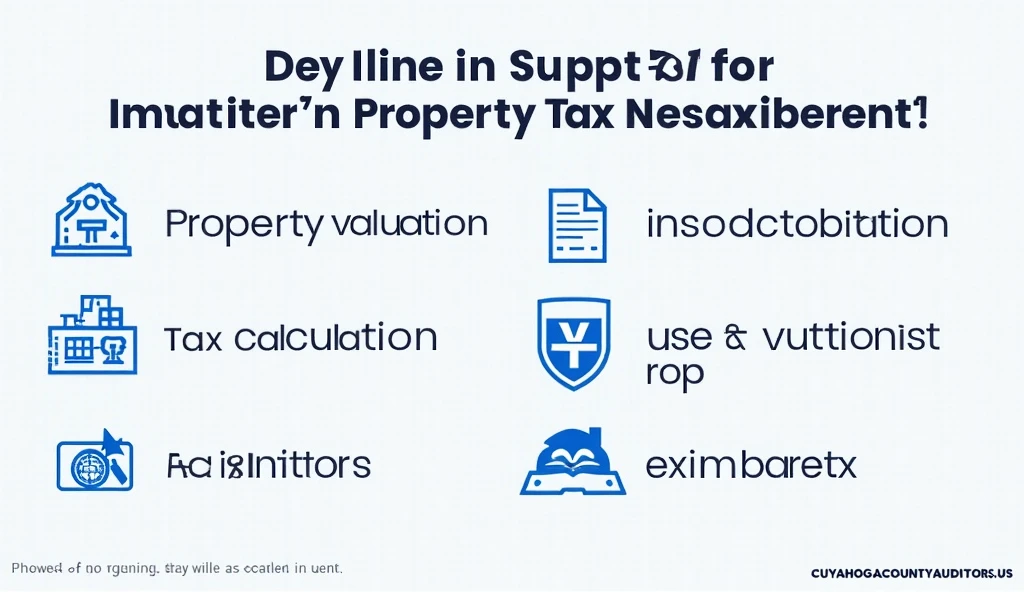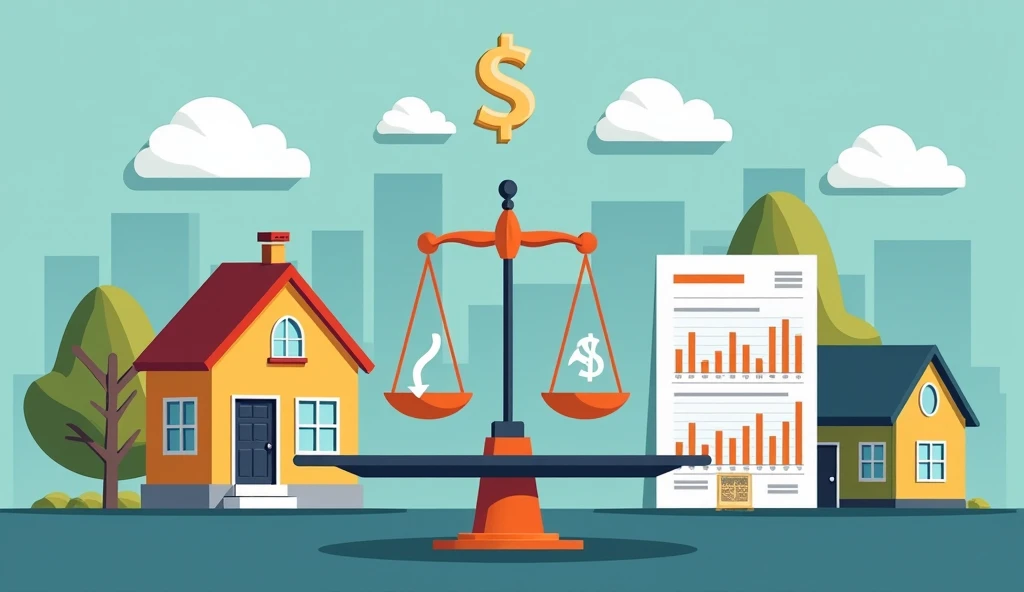Introduction
Property taxes are essential for funding local services that everyone relies on—such as schools, law enforcement, roads, and emergency services. In Cuyahoga County, Ohio, the County Auditor plays a vital role in making sure that these taxes are distributed fairly. This is done through the property tax assessment process, where the Auditor determines the value of all properties in the county.
The Auditor’s role goes beyond simply assessing property values. It involves evaluating each piece of property with fairness and accuracy, ensuring that the right amount of tax is levied on each property. The work carried out by the County Auditor ensures the county’s finances are maintained fairly while protecting property owners from being overcharged.
This article will explain the key responsibilities of the Cuyahoga County Auditor in property tax assessment, and how their actions directly impact homeowners, businesses, and local services.

1. Core Functions of the County Auditor in Tax Assessment
1.1 Property Valuation Authority
The most significant responsibility of the Cuyahoga County Auditor is to determine the market value of every property in the county. This process is not a simple one—it requires thorough research and analysis. The Auditor conducts reappraisals of properties every six years, and adjusts values based on the current market every three years.
Valuations are based on many factors, including:
- Square footage of the property
- Age and condition of the structure
- The neighborhood and market conditions
- Recent sales data for similar properties
These factors help the Auditor calculate a fair market value that determines how much tax a property owner will owe.
1.2 Classification and Exemption Review
Not all properties are treated the same. The Auditor classifies properties into categories like residential, commercial, industrial, and agricultural. Some properties may even be tax-exempt, such as churches and non-profit organizations.
The classification determines the tax rate applied to the property, as well as any exemptions the property may qualify for. For instance, there are homestead exemptions for seniors or those with disabilities, which lower the amount of taxes owed.
2. Updating Property Records and Improvements
2.1 New Construction and Permits
Whenever a new construction project takes place or property improvements are made—whether it’s adding an extension or completely rebuilding—the Auditor’s office must ensure the property value is updated. This process includes:
- Reviewing construction permits submitted by the owner
- Verifying the changes made to the property
- Adjusting the property’s tax value accordingly
Failing to update these records after improvements can lead to unfair tax assessments for property owners.
2.2 Parcel Maintenance and GIS Mapping
Cuyahoga County uses advanced Geographic Information System (GIS) technology to manage property data. GIS allows the Auditor’s office to maintain accurate records of property boundaries, as well as other important features like:
- Zoning areas
- Building locations
- Property splits and combinations
GIS helps the public access detailed information about their properties and also aids in ensuring assessments are accurate.

3. Applying Tax Rates and Levy Distribution
3.1 Tax Rate Calculation and Certification
Once the market value of a property is determined, the Auditor applies the tax rates approved by local voters and other taxing authorities, like school districts and cities. The Auditor’s role is to certify the total tax amount that each property owner will need to pay.
While the Auditor doesn’t decide the tax rates themselves, they apply these rates to each property’s assessed value. This ensures that property owners are paying the appropriate share of taxes.
3.2 Apportionment of Revenue
Once the taxes are collected, the Auditor makes sure the revenue is distributed to the appropriate entities, such as:
- Public schools
- Local governments
- Libraries
- Special districts
This process ensures that all of these entities receive their fair share of the tax revenue needed to fund their programs and services.
4. Fairness, Transparency, and Legal Compliance
4.1 Board of Revision and Property Appeals
Property owners in Cuyahoga County have the right to challenge their property assessments if they feel their property has been overvalued. The Cuyahoga County Board of Revision (BOR) provides a process for owners to appeal the assessed value.
The Auditor’s office works alongside the BOR to review property owners’ concerns, gather evidence, and ensure fair decisions are made during the appeal process.
4.2 Public Access to Information
The Auditor believes in transparency. That’s why the office makes important property information available to the public. The public can use online tools to search for details about their property, look at tax records, and even review historical property values.
This open access ensures that all property owners can understand how their tax assessments are made and verify that they are being treated fairly.

5. Use of Technology in Property Assessment
Technology has become an essential tool for the Auditor’s office. The use of aerial imagery, satellite technology, and automated valuation systems has made the assessment process more accurate and efficient.
By using modern technology, the Auditor can:
- Detect unreported changes to properties
- Improve the accuracy of property valuations
- Provide digital maps and information to the public
Technology helps streamline the assessment process and ensures that the tax roll is fair and transparent for everyone.
6. Community Impact and Economic Significance
6.1 Equity in Public Finance
A fair property tax system ensures that everyone contributes their fair share to the funding of local services. The Auditor’s job is crucial in making sure property values are accurate, and that taxes are distributed equitably.
If property assessments were inaccurate, some property owners could end up paying too much, while others might be paying too little. By ensuring fairness in property assessments, the Auditor helps create a balanced, sustainable tax system that supports vital public services.
6.2 Support for Housing and Urban Policy
The data the Auditor collects isn’t just useful for tax purposes—it also helps guide local government decisions. Accurate property records assist in urban planning, housing policy, and economic development. These records support decisions on where to invest in infrastructure, how to allocate funding, and how to plan for future growth in the community.
Conclusion
The Cuyahoga County Auditor plays a critical role in ensuring that property tax assessments are accurate, fair, and transparent. From determining property values and handling exemptions to using advanced technology for efficiency, the Auditor’s responsibilities are both wide-ranging and essential.
By maintaining fairness in property taxation, the Auditor helps fund local services that improve the quality of life for all residents. Understanding the Auditor’s role can empower property owners to engage with the system, appeal unfair assessments, and ensure they are paying their fair share of taxes.
Cuyahoga County Auditor’s Role in Property Tax Assessment
| Aspect | Description |
|---|---|
| Property Valuation | The Auditor assesses property values every 6 years, with updates every 3 years based on market changes. Uses factors like size, condition, and location. |
| Reappraisal Frequency | Properties are reappraised every 6 years, and values are adjusted every 3 years to reflect market conditions. |
| Tax Rate Determination | Local authorities set the tax rates, but the Auditor ensures they are applied fairly to the assessed value of properties. |
| Exemptions | The Auditor manages various exemptions, such as the homestead exemption, to provide tax relief for qualifying property owners. |
| Appeal Process | Property owners can appeal assessments through the Board of Revision by providing evidence like comparable sales or an independent appraisal. |
| Role in Local Services | Property tax revenue is used to fund local services like schools, public safety, and infrastructure. The Auditor ensures proper distribution of this revenue. |
| GIS Technology | The Auditor uses GIS technology to map and track properties, enhancing the accuracy of assessments and public access to property data. |
| Under-Assessed Properties | The Auditor works to correct under-assessed properties during reappraisals or audits to ensure tax fairness. |
| New Construction/Improvements | The Auditor adjusts property assessments when new construction or improvements are made to ensure accurate tax calculations. |
| Property Classification | Properties are classified into categories (residential, commercial, industrial, agricultural) with varying tax rates, ensuring proper taxation based on use. |
1. What is the role of the Cuyahoga County Auditor in property tax assessment?
The Cuyahoga County Auditor plays a central role in the property tax assessment process. Their primary responsibility is to determine the market value of all properties in the county. They conduct reappraisals every six years and update property values every three years. The Auditor ensures that the tax assessments are accurate, fair, and in compliance with Ohio laws. They also manage property classifications, exemptions, and facilitate the tax levy process. This guarantees that the correct amount of property tax is levied on each property, benefiting local public services.
2. How does the Cuyahoga County Auditor determine property values?
The Auditor determines property values based on several factors, including recent sales data of similar properties, the property’s size, condition, and location. Each property is reappraised every six years, and values are adjusted every three years to reflect market changes. The Auditor uses mass appraisal techniques, ensuring consistency across all properties. This process includes physical inspections, as well as gathering data on property improvements or damages. Through this, the Auditor aims to assess properties at their fair market value, balancing fairness for property owners and revenue needs for local services.
3. What is the process for property owners to appeal their property tax assessment in Cuyahoga County?
If a property owner believes their property tax assessment is inaccurate, they can appeal through the Cuyahoga County Board of Revision. The appeal process involves filing a formal application within the designated time frame, typically after receiving the Notice of Valuation. Property owners must present evidence to support their claim that the assessed value is too high, such as comparable sales data or a recent independent appraisal. The Board reviews the appeal and makes a decision. This ensures a fair opportunity for property owners to challenge assessments that may not reflect actual market values.
4. How are property tax rates determined in Cuyahoga County?
Property tax rates in Cuyahoga County are determined by local governing bodies, such as school districts, municipalities, and other public service districts. These authorities decide on the levy amounts, which are then applied to the assessed value of each property. The Auditor’s office ensures that these tax rates are fairly applied across all property types. While the Auditor doesn’t set the tax rates, they play a key role in distributing the collected taxes to the appropriate entities, ensuring that local governments, schools, and public services receive their fair share of revenue.
5. What is the role of exemptions in property tax assessments in Cuyahoga County?
Exemptions play an essential role in property tax assessments by reducing the taxable value of certain properties. In Cuyahoga County, property owners may qualify for various exemptions, such as the homestead exemption for seniors or individuals with disabilities. These exemptions lower the assessed value of the property, thereby reducing the amount of property tax owed. The Auditor’s office reviews each exemption application to ensure it meets the criteria. By managing exemptions effectively, the Auditor ensures that deserving property owners receive the tax relief they are entitled to, making the tax system more equitable.
6. How often does the Cuyahoga County Auditor conduct property reappraisals?
The Cuyahoga County Auditor conducts property reappraisals every six years. During this process, the value of each property in the county is reassessed to reflect current market conditions. Reappraisals take into account recent sales data, property improvements, and changes in the local market. The Auditor also adjusts property values every three years to ensure they stay in line with fluctuations in the real estate market. This regular revaluation helps ensure that property taxes are based on fair, accurate assessments and that property owners pay taxes in accordance with the current market value of their properties.
7. What is the purpose of a property classification in Cuyahoga County?
In Cuyahoga County, property classification is crucial for determining how much tax a property owner must pay. Properties are classified into categories like residential, commercial, industrial, and agricultural. Each classification is subject to a different tax rate, with agricultural properties often receiving favorable rates. This classification process helps ensure that different types of properties are taxed appropriately based on their use and market characteristics. The Cuyahoga County Auditor ensures that each property is correctly classified, ensuring that tax rates are applied fairly and in accordance with local laws.
8. How does the Cuyahoga County Auditor use GIS technology in property tax assessments?
The Cuyahoga County Auditor utilizes Geographic Information System (GIS) technology to accurately map and track properties throughout the county. GIS allows the Auditor to maintain detailed digital records of property locations, boundaries, zoning areas, and more. This technology supports the assessment process by helping the Auditor visualize properties, monitor changes such as splits or improvements, and keep accurate data. GIS also provides the public with access to online property maps and information, offering transparency and improving the overall efficiency of property tax assessments in the county.
9. What is the importance of property tax assessments for local public services?
Property tax assessments are vital for funding local public services, including schools, police and fire departments, and infrastructure projects like roads and public buildings. By accurately assessing property values and applying appropriate tax rates, the Cuyahoga County Auditor ensures that local governments and services receive the revenue they need to function. Without accurate property tax assessments, the county may experience budget deficits, which could impact the quality of public services. The Auditor’s work ensures the fair distribution of tax revenue, supporting the well-being of all residents in Cuyahoga County.
10. How can property owners stay informed about property tax changes in Cuyahoga County?
Property owners in Cuyahoga County can stay informed about changes in property tax assessments by regularly checking the Cuyahoga County Auditor’s website. The site provides updates on reappraisals, tax rate changes, and new exemptions. Property owners will also receive Notices of Valuation from the Auditor when their property is reassessed. Additionally, the Auditor’s office holds public meetings where community members can learn about the tax process and ask questions. Staying informed helps property owners understand how changes in property value and tax rates may affect their tax bills.
11. Can a property owner appeal the Auditor’s valuation even after paying their taxes?
Yes, a property owner can appeal the Auditor’s property valuation even after they have paid their taxes. In Cuyahoga County, property owners have the right to challenge the assessment through the Board of Revision process, which allows them to submit an appeal and provide evidence that the assessment was incorrect. If successful, the property’s value may be adjusted, leading to a reduction in property taxes. It’s important for property owners to file their appeal promptly, as there are strict deadlines for challenging assessments.
12. What factors influence the property valuation in Cuyahoga County?
Several factors influence property valuations in Cuyahoga County, including the size of the property, its location, and the condition of the building. Additionally, recent sales data of similar properties and changes in the local real estate market play a significant role in determining a property’s value. The Auditor’s office uses these factors to ensure that each property is assessed fairly and in line with its true market value. By considering all relevant data, the Auditor helps create an equitable property tax system that reflects current market conditions.
13. What happens if a property is under-assessed in Cuyahoga County?
If a property is under-assessed in Cuyahoga County, the owner may benefit from lower property taxes, but this can create an inequitable tax system. The Cuyahoga County Auditor works to correct under-assessed properties during routine reappraisals and through the tax audit process. If discrepancies are discovered, the Auditor may adjust the property’s valuation to ensure that it reflects the current market value. This helps maintain fairness, ensuring that all property owners pay their fair share of taxes based on accurate assessments.
14. How does the Auditor handle new construction or property improvements?
When new construction or property improvements occur, the Cuyahoga County Auditor ensures that the property’s value is updated accordingly. The Auditor’s office receives reports of new construction permits, and once improvements are verified, the property’s assessed value is adjusted. This ensures that the property tax reflects the current condition of the property. If improvements go unreported, it may lead to an incorrect assessment, which the Auditor strives to avoid through regular updates and careful monitoring of property records.
15. What role does the Cuyahoga County Auditor play in tax levy distribution?
The Cuyahoga County Auditor plays a key role in ensuring that the tax revenue collected from property owners is distributed fairly among local governments, schools, and other public services. Once taxes are collected, the Auditor’s office ensures that each entity receives its share based on approved tax rates. This process involves detailed calculations and certifications, ensuring that public services have the necessary funds to operate efficiently. By managing levy distribution, the Auditor helps maintain the financial health of local institutions and services in Cuyahoga County.
